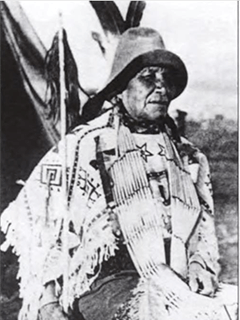Moving Robe Woman facts for kids
Quick facts for kids
Moving Robe Woman
|
|
|---|---|
| Sioux, Tȟašína Máni | |
 |
|
| Personal details | |
| Born | 1854 |
| Died | 1935 (aged 80–81) Standing Rock Reservation, South Dakota |
| Parents | Father, Crawler. Mother, Sunflower Face. |
| Known for | Fought against Custer during the Battle of Little Big Horn to avenge her brother, One Hawk |
| Nicknames | Mary Crawler, Her Eagle Robe, She Walks With Her Shawl, and Walking Blanket Woman |
Moving Robe Woman (Sioux name Tȟašína Máni) was a brave Hunkpapa Sioux woman. She is also known by names like Mary Crawler, Her Eagle Robe, and Walking Blanket Woman. She is famous for fighting in the Battle of the Little Bighorn to avenge her brother, One Hawk, who had been killed.
Contents
Her Early Life
Moving Robe Woman was born in 1854 near what is now Grand River, South Dakota. Her father was named Crawler, who was a Hunkpapa chief. Her mother was Sunflower Face.
When she was about 17 years old, Moving Robe Woman joined a war party. They traveled to Montana to fight against the Crow tribe. Around age 22, she and her family moved to a place the Lakota people called Peji Sla Wakapa. This place is known in English as the Little Bighorn.
The Battle of Little Bighorn
When Moving Robe Woman was 23, she heard terrible news. Her parents told her that her brother, One Hawk, had been killed. He died at the hands of soldiers led by Pehin Hanska, which was the Lakota name for General Custer.
Soon after, soldiers on horseback charged into the large Lakota village. It was near the Greasy Grass River, and they began firing their guns. This was the start of the Battle of Little Bighorn.
Later in the battle, an Oglala Lakota warrior named Fast Eagle said something important. He claimed he held Custer's arms while Moving Robe Woman stabbed Custer in the back. However, many other warriors also claimed to have killed Custer. It is not certain if Moving Robe Woman was the one who killed him. Records from after the battle do not mention Custer having stab wounds. Officers who found his body said he died from gunshot wounds.
Moving Robe Woman did avenge her brother's death in the battle. She killed two of Custer's men. She used a knife to kill one soldier. She used a revolver to kill the other, who was an army interpreter named Isaiah Dorman.
Later Years
After the Battle of Little Bighorn ended, Moving Robe Woman moved with her people. They went to Canada and stayed there until 1881. Then, she moved back to the United States. She settled in the Kenel area of the Standing Rock Indian Reservation in South Dakota.
A survey from 1923 noted details about her life. At age 70, Moving Robe Woman lived alone. She had a one-room log house with a barn attached. This home was on the Grand River, west of Bullhead, South Dakota. The survey also said she owned 18 horses and 23 cattle. She passed away in 1935.
Her Own Words
An interview with Moving Robe Woman was published in a book. It was done by Frank B. Zahn at Fort Yates, North Dakota. In the interview, she shared her feelings when she heard about her brother's death at Little Bighorn:
"My Heart was bad. Revenge! Revenge! For my brother's death. I thought of the death of my young brother, One Hawk. I ran to a nearby thicket and got my black horse. I painted my face with crimson and braided my black hair. I was mourning. I was a woman, but I was not afraid."
Visual Art and Photos
A photograph of Moving Robe Woman was taken in 1937 by F.B. Fiske. She was 83 years old at the time. This photo is kept at the National Anthropological Archives of the Smithsonian Institution.
An American artist named Thom Ross created a large art project about the battle. It has 200 pieces, including a painting of Moving Robe Woman.
See also

